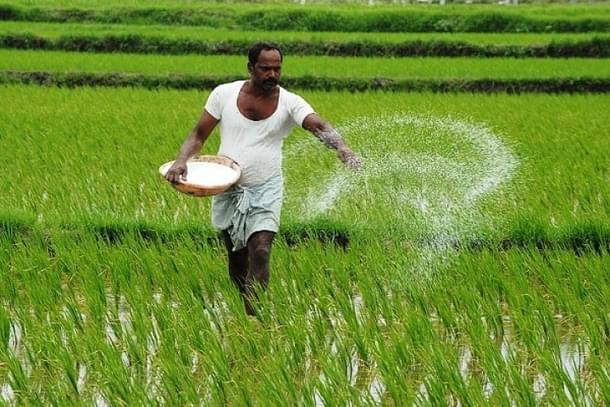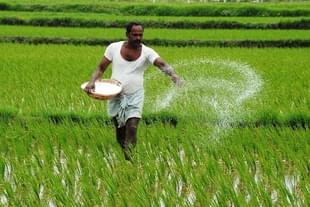Ideas
Farm Bills Are Latest In The Sequential Liberalisation Of Agricultural Sector
TV Mohandas Pai and Nisha Holla
Oct 20, 2020, 12:40 PM | Updated 12:39 PM IST
Save & read from anywhere!
Bookmark stories for easy access on any device or the Swarajya app.


The farm bills are liberating farmers at a pivotal juncture when the composition of the gross value added (GVA) in the agricultural sector is rapidly changing. Crops, specifically cereals, once dominated the sector, and multiple controls were placed to ensure aggregation, distribution and supply.
The minimum support price (MSP) evolved as a mechanism to guard farmers against supply and demand shocks in the cereals segment.
Now, however, farmers and agricultural producers have diversified their product segments, cereals no longer dominate production, and the old control mechanisms no longer hold sway.
Connecting farmers directly to the market and consumers is increasing farmer incomes by 20-30 per cent, as demonstrated by more than 600 agri-tech companies that have validated the value proposition over the last five-seven years. Harnessing the value of these trendlines requires a forward-looking policy environment which the farm bills are the latest in implementing.
In the last decade itself, India has witnessed tremendous change in the GVA composition of the agri-sector. The share of crops has decreased from 65.4 per cent in 2011-12 to 55.3 per cent in 2018-19, projected to further fall to 45.6 per cent in 2024-25. Within crops, only cereals are supported by MSP.
In the same period, value add of livestock and fishing and aquaculture is steadily increasing, as are the total value outputs of sub-segments like horticulture, milk and meat.
With differentiated production strategies that are less reliant on cereals and more on other segments, farmers are accruing better incomes. By diversifying their produce, they are moving away from one-crop risks.
Three bills were recently passed to make farmers more independent and to improve their earning ability — the Farmers’ Produce Trade and Commerce Bill, Farmers Agreement on Price Assurance and Farm Services Bill, and Essential Commodities (Amendment) Bill.
These bills endeavour to hand back agency to the Indian farmer. They enable farmers the freedom to diversify their crops and produce, which reduces mono-crop dependence and increases income avenues.
They can also now sell their produce anywhere, to the highest bidder across the country; no longer are they required to go to the mandis where they are subject to middlemen and layers of bureaucracy.
Contract farming is now open to farmers, with a framework that enables them to boost the value-add of their products via contracts and assured procurement by the food processing industries. Retaining the MSP system means the government is underwriting the whole network for certain crops to ensure farmers receive assured income for those crops. Government of India has procured 5.73 lakh tonnes of paddy worth Rs 1,082 crore at MSP since the last week of September 2020.
Structural changes were required in the agricultural system to improve the livelihoods of Indian farmers. Keeping them dependent on subsidies and restricted by APMCs and acts like the Essential Commodities Act wasn’t in the nation’s long-term interests. Recognising this, the Narendra Modi government has been making sequential changes in the system.
It started with the introduction of the National Agriculture Market (e-NAM) to facilitate online trading of agri-produce. Then PM-KISAN was introduced to provide minimum income support to 9 crore marginal farmers at Rs 6,000 annually.
These beneficiaries don’t benefit from MSP, which applies only to 6 per cent of farmers, mainly in the legacy farming regions like Punjab and Haryana. The first instalment of PM-KISAN Rs 2,000 per farmer was front-ended during the Covid-lockdown to protect the interests of the farmer. This income support was crucial in harvesting the record rabi crop cycle in April 2020 and sowing the kharif crops. Record procurement was also undertaken in April 2020.
The last four months, in particular, have brought many changes and support schemes for farmers. The KISAN credit card with an allotment of a total of Rs 2 lakh crore credit to maintain larger workforces and implements during harvest season is helping farmers plan and organise their harvests better, leading to increased production and incomes. It also enables farmers to build formal credit histories linked to Aadhaar that can be capitalised on to avail credit for expansion and diversification strategies.
An important announcement has been the Rs 1 lakh crore Agri Infrastructure Fund as part of Atmanirbhar Bharat Abhiyan to focus on farm-gate and aggregation points, agricultural entrepreneurs, agri-tech companies, disease control, enhancing post-harvest management capabilities like cold storage and warehousing, and formalisation of Micro Food Enterprises via a cluster-based approach.
Recognising the crucial differences in growth of sub-segments, targeted programmes towards the various sub-segments like fisheries, animal husbandry, and dairy were also launched along with long-awaited amendments to the Essential Commodities Act 1955.
On the support of these sequential abutments to the agricultural industry, the three farmer bills enable farmers to pursue their own farming and diversification strategies.
The numerous protests against the bills expose the political and vested interests in restricting the agency of the farmers.
Meanwhile, the government of India has announced that the various subsidies that farmers avail will continue while these bills are put into action, thus providing valuable support to farmers and ensuring continuity of relief as farmers pursue new strategies.
Over time, this independence-with-support model will lead to increased incomes for farmers and overall increased contribution of the agricultural sector to India’s gross domestic product (GDP), compared to the current 17 per cent. Crucially, it will liberate 43 per cent of the national workforce that depends on agriculture for livelihood and sustenance.
This also gives India the long-awaited opportunity to orient its agriculture sector towards export markets. By catering to just the Indian economy, the exposure is hardly $3 trillion (pre-Covid GDP); instead, export-orientation caters to an $82 trillion global economy (pre-Covid) – a 27x expansion.
Agri exports by the US in 2018 were valued at $140 billion whereas India’s at $38.5 billion.
India can comfortably triple this by providing infrastructure for grading, sorting, and supply chain distribution which is now possible due to the freedom given by the bills. The nation and farmers have a generational opportunity here to break out of a 70-year sectoral stagnation and aim bigger.
This article first appeared in Financial Express, and has been republished here with permission.
T V Mohandas Pai is Chairman, Aarin Capital Partners and Nisha Holla is Technology Fellow, C-CAMP.
TV Mohandas Pai is Chairman, 3one4 Capital, and Nisha Holla is Research Fellow, 3one4 Capital





